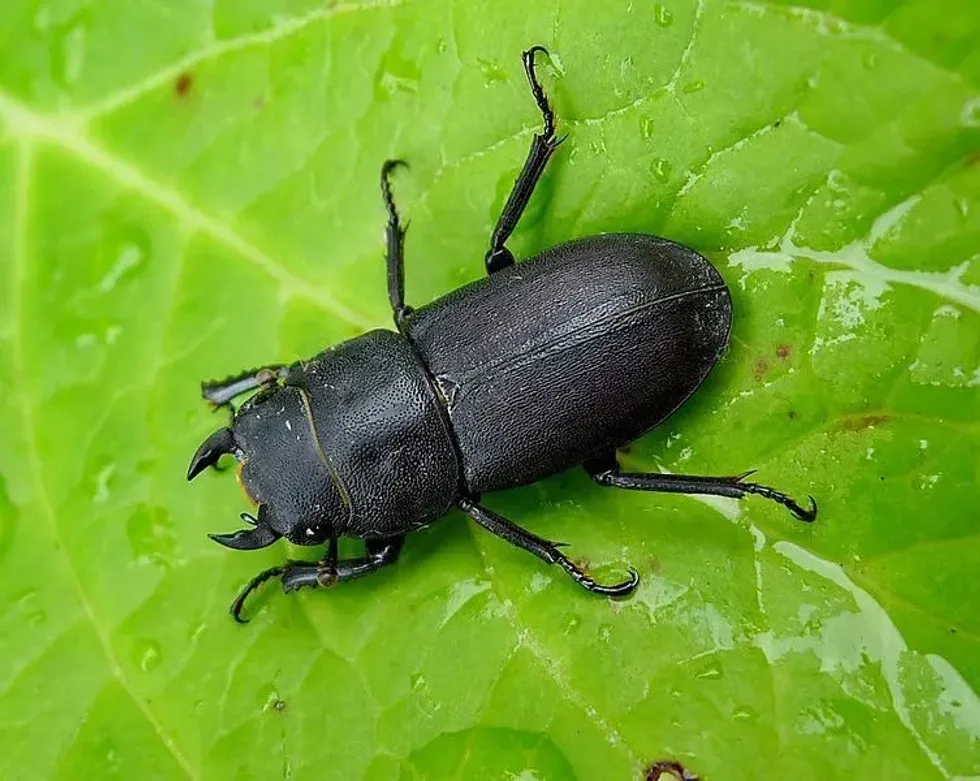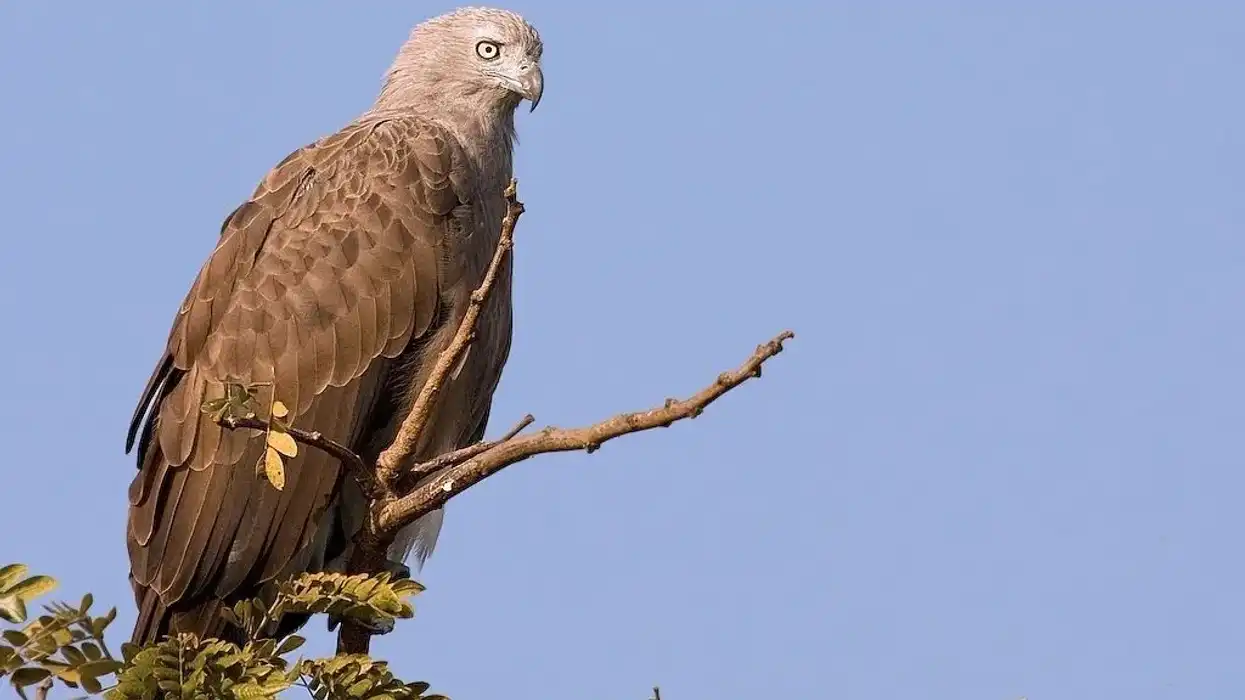The lesser stag beetle (Dorcus parallelipipedus) is a species of small stag beetle native to England and Wales. This reclusive beetle is nocturnal in nature and is only rarely seen. It can be identified by its shiny, black body and wings along with its strong protruding jaws, that resemble the antlers of a stag.
These beetles spend most of their lifespan in larvae form, eating their way through dead wood until they grow enough to emerge as adult beetles. Females lay their eggs on pieces of decaying wood or on tree stumps, after which the eggs hatch and burrow inside the soft wood.
Even after hatching, these shy beetles spend most of their time hidden. These beetles have adapted well to urban surroundings, and can often be found in sheds, potted plants, or around one's garden.
To learn more about this fantastic beetle, read on! For more relatable content, check out these bombardier beetle facts and rove beetle facts for kids.
Lesser Stag Beetle Interesting Facts
What type of animal is a lesser stag beetle?
The lesser stag beetle is a type of insect species belonging to the family Lucanidae.
What class of animal does a lesser stag beetle belong to?
The lesser stag beetle belongs to the class Insecta.
How many lesser stag beetles are there in the world?
Due to its large population and widespread presence, the exact number of lesser stag beetles in the world has not been calculated. However, we do know that they are found abundantly and are currently in no danger of extinction.
Where does a lesser stag beetle live?
The lesser stag beetle is native to England and Wales and is more widely distributed than the stag beetle. It is scarce in the northern part of the country because this beetle prefers warmer areas.
What is a lesser stag beetle's habitat?
Unlike the stag beetle which spends most of its life underground, the lesser stag beetle undergoes its whole life cycle aboveground, albeit hidden inside rotting wood, old tree stumps, and hollows. They prefer broad-leafed trees and can commonly be found in dead apple, ash, and beech trees.
They are shy creatures and stay mostly to their habitat. Not much is known about them due to their nocturnal tendencies. They have been spotted in parks and are a common garden sight, nesting in dead trees and potted plants.
Who do lesser stag beetles live with?
These beetles spend the first one to two years of their lives as pupae, living inside rotting and decaying wood and tree stumps aboveground, feeding on the debris. They live together in tree trunks. After emerging from their pupae stage, they set out to seek mates.
How long does a lesser stag beetle live?
Lesser stag beetles have been observed to live for around one to three years. Unlike other stag beetles, lesser stag beetles do not die immediately after mating, going on to live for an extra one to two years.
How do they reproduce?
These beetles are ready to mate as soon as they emerge from their pupae shells in their adult form, which occurs mostly during the summer from May to September. Adult females secrete chemical pheromones which attract a number of males.
Males wrestle each other with their large protruding jaws in order to win the female.
Once the pairs mate, the females lay a number of eggs onto a suitable piece of decaying wood in a park, garden, or woodland.
The eggs then hatch and the larvae burrow inside where they remain for the next one or two years. The larvae continue to thrive inside the rotting wood and on dead wood until they emerge as adults during the next breeding season.
What is their conservation status?
The current conservation status of these beetles is Not Evaluated by the IUCN, simply being listed as not extinct.
Lesser Stag Beetle Fun Facts
What do lesser stag beetles look like?
Lesser stag beetles look similar to their larger cousin, the North American antelope beetle (Dorcus parallelus). Their bodies are divided into three, distinct sections covered in a hard, shiny matte black exoskeleton.
Both sexes look similar, with males being identified due to the presence of larger jaws and knobbed mandibles. The female stag beetle is also smaller in size than the male.
Lesser stag beetle larvae are white and distinctively C-shaped like all other stag beetle larvae.
How cute are they?
Despite having large, scary-looking mandibles and a tough outer shell, these beetles are actually quite shy and seeing one of these in your garden is a special treat.
How do they communicate?
Female stag beetles release chemicals known as pheromones when they are ready to mate in order to attract males. Stag beetle larvae are known to communicate with a soft gurgling sound by rubbing together their body parts which is known as 'stridulation'.
How big is a lesser stag beetle?
Lesser stag beetles have been observed to measure between a range of 0.8-1.6 in (2-4 cm). They are in the same range as water beetles and a bit bigger than green June beetles.
How fast can lesser stag beetles move?
As these beetles spend most of their time underground, their movements have not been observed too much. When above ground, they are mostly stationary, being seen on tree trunks or among planted pots.
How much does a lesser stag beetle weigh?
As the lesser stag beetle species is highly reclusive and has not been observed that much, their exact weight has not been recorded like ground beetles.
What are the male and female names of the species?
There are no specific names for either sex of this species, simply being called female or male stag beetles.
What would you call a baby lesser stag beetle?
Baby stag beetles are known as grubs or larvae.
What do they eat?
Stag beetle larvae depend on dead or decaying wood in their habitat as their primary source of food. Once they hatch into adult beetles, they can no longer consume solid food, instead living off stored fat in their bodies. They can be found drinking nectar from flowers, sap, and lapping up soft rotten fruit with their tongues.
Are they harmful?
The lesser stag beetle is not poisonous at all and will not bite unprovoked. The female stag beetle is more likely to bite humans than males, and will only do so if picked up.
Males mostly use their large jaws only to fight other male stag beetles in order to impress their mate. They are very shy creatures and are rarely found outside. They can be spotted flying about parks and gardens at night, or resting on the sides of tree trunks and potted plants during the summer.
Would they make a good pet?
Stag beetles are a very popular pet in Japan. Though in England, this reclusive beetle species is not sought after as a pet as they are rarely spotted. They have a relatively short life cycle and adults are very difficult to find. Females can also be aggressive, biting anyone who picks them up.
If searched for, they can be found living in decaying wood stumps in parks and gardens and admired there. The larvae of these beetles are quite useful as they feed on dead wood, helping to dispose off dead trees naturally.
Did you know...
Unlike most stag beetle species, once lesser stag beetle adults mate and lay their eggs on dead wood, they do not die. They continue to live on for around one to two years and their total life cycle is around three or more years.
Do adult lesser stag beetles eat?
No, stag beetle adults are unable to eat solid food, instead finding sustenance from the fat stored in their bodies. They can however drink and feed themselves on nectar, flower sap, and squishy rotten fruit.
What is the difference between lesser stag beetles vs. stag beetles?
Lesser stag beetles look similar to larger stag beetle species, however can be identified due to their all-black color scheme and smaller size. Most stag beetles have chestnut-brown wings, whereas lesser stag beetles are black in color.
The mandibles of male lesser stag beetle adults are also much smaller than those of other, bigger species. The lesser stag beetle is exclusively found in England and Wales.
Here at Kidadl, we have carefully created lots of interesting family-friendly animal facts for everyone to discover! Learn more about some other arthropods from our jewel beetle surprising facts and fungus beetle fun facts pages.
You can even occupy yourself at home by coloring in one of our free printable stag beetle coloring pages.









